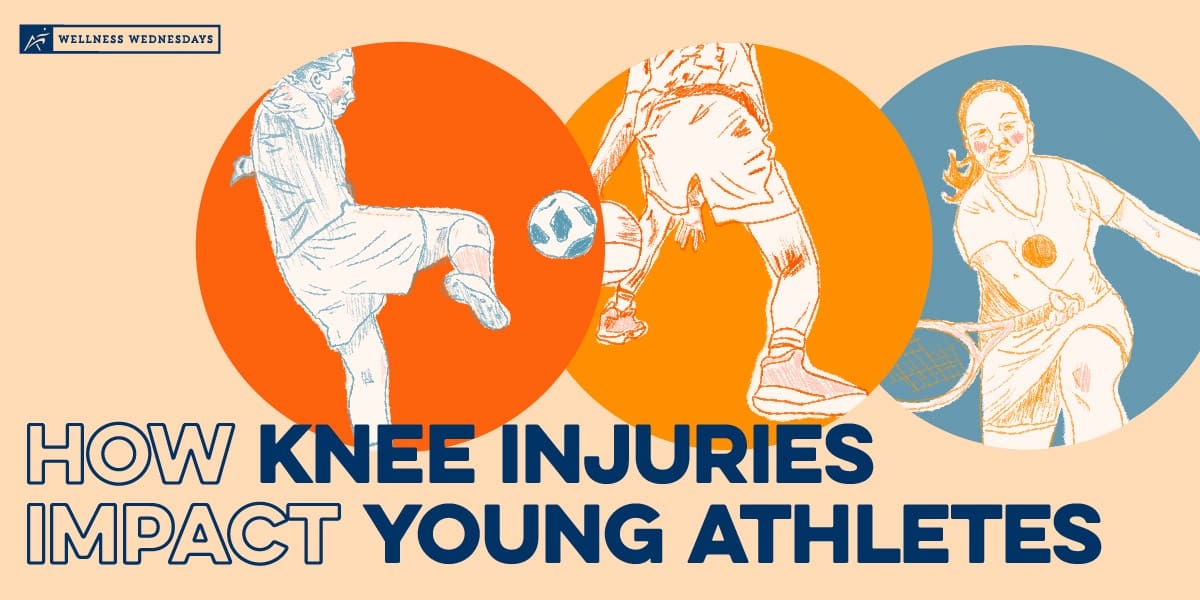Whether during a game, scrimmage, or training, one of the biggest fears for young athletes is sustaining an injury that keeps them away from the sport they love. Proper training and stability are crucial to keeping a young athlete healthy and pain free while on the field .
The knee is made up of several different components that all function together to provide mobility to our bodies. Because of its functionality, the knee is also highly susceptible to injury, especially in young athletes. Sometimes, all it takes is one wrong movement to cause an injury. This is especially true for athletes whose bodies are still growing and learning to coordinate.
Continue reading to learn common injuries in younger athletes, as well as preventative action, and how Airrosti can aid in recovery! Airrosti providers are here to guide you on the proper ways to train, as well as assist in any injuries that may happen along the way. Schedule your appointment today.
Common Knee Injuries In Young Athletes
Knee injuries in young athletes are often caused by a fall or a blow to the knee. Sports like basketball, soccer, and football all rely on joints for quick movements such as pivoting or jumping. These repetitive movements can pose quite a risk for younger athletes, especially if they are performed with improper form. This risk is increased if their bodies are already strained from overexertion.
A few of the most common knee injuries in young athletes are:
- Osgood-Schlatter Disease
- Ligament tears, especially ACL and MCL
- Patellar Tendonitis (Jumper’s Knee)
While some injuries, like patellar tendonitis and Osgood-Schlatter disease, often resolve themselves given enough time and rest, others have severe and long-lasting consequences. More severe injuries, such as fractures or tears, could possibly require surgery and physical therapy for weeks, if not months, and have the potential to end athletic careers.
Severe injuries, like an ACL tear, are notorious for setting an athlete back physically and mentally. Not only will these injuries cause athletes to fall behind in their training, but they can cause emotional strain to athletes who must watch from the sidelines or miss a season altogether.
Fortunately, sports medicine has improved dramatically over the years, and treatment methods for even the most severe injuries have evolved for the better. Although these injuries can still test a young athlete’s resolve, they are no longer considered the “career-enders” that they were years ago.
Knee Injuries On The Field: First Aid & Treatment Tips
Whether you’ve been hurt during a game, or injured off the field, the first thing to do is follow the RICE method to ensure your knee doesn’t sustain further damage.
Rest: Stay off the injured knee as much as you can. If the injury is severe, you may need the help of a teammate to move to a safe area. Do not try to “walk it off” when you first feel pain, as this likely will make the injury worse.
Ice: If you notice any swelling or redness, keep an ice pack on your knee to help reduce inflammation and control blood flow. Keep the ice pack on the area for 20 minutes at a time, giving yourself a break every 20 minutes to re-examine the area.
Compression: Wrapping the injured knee in an elastic medical bandage can also help decrease swelling. Keep the wrap snug around the knee, but not too tightly. Loosen the bandage if you feel any numbness or tingling below the wrapped area.
Elevation: Keep the injured leg elevated above your heart. Not only does this reduce the swelling by controlling blood flow, but it can also reduce pain. An easy way to elevate your leg is to prop it up on pillows while lying down.
You might find that even after recovery, your body is not performing like it used to. Depending on how much time it took to recover, you might detect signs of muscle weakness and reduced range of motion. To combat this, slowly strengthen your muscles and increase your mobility with targeted stretches and exercise, remembering to rest when needed.
Improving Knee Strength And Stability
Your hamstrings, glutes, quads, and calves are all powerful muscles that support and stabilize the knee joint. These muscles must work together to ensure the knee is able to support your weight during movement. Weakness or imbalance in these muscles could lead to a serious knee injury down the road.
To help boost your recovery and improve your overall performance, focus on building strength in each of these muscles. In the video below, Raymond Sue, DC demonstrates a few exercises that you can add to your daily routine to help strengthen these important muscles and improve knee stability.
*Disclaimer: Always consult with your doctor before starting any exercise program. If you experience any numbness, tingling or reproduction of your symptoms, please contact your doctor.
Get Back In The Game With Airrosti
Airrosti is dedicated to helping athletic patients get back on the field quickly, competing in the sports and activities they love. Airrosti Certified Providers treat hundreds of athletes, from young students to professional competitors.
If a recent knee injury is keeping you off the field, schedule an appointment with an Airrosti provider today. Whether it’s in-clinic or remote, at Airrosti, our providers take the time needed to properly assess and treat the root cause of your pain and resolve injuries at the source.
Read our Medical Disclaimer here.









